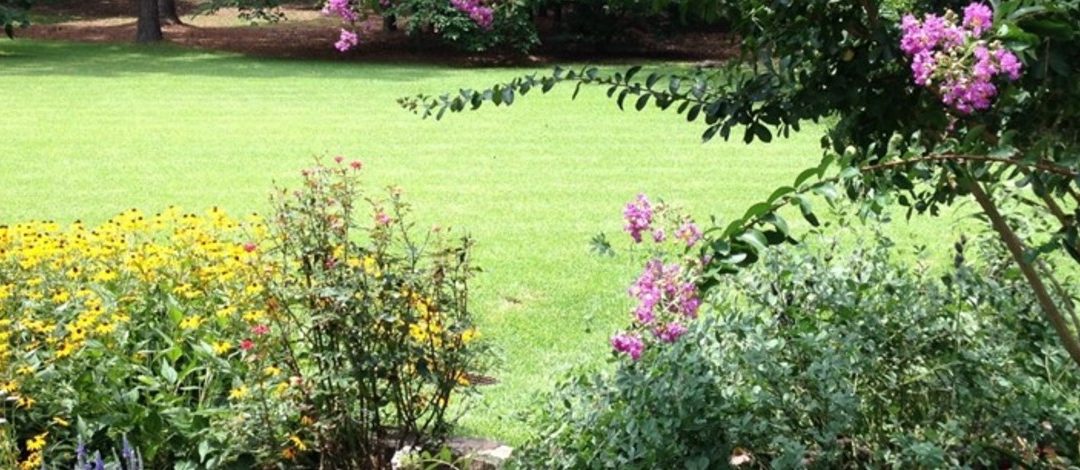
by Larry Williams | Oct 30, 2025
Over time, landscapes change and our needs change. Lawns, shrubs and trees are living and respond to their environment, growing and declining with time. Many older landscapes eventually need renovation and improvements. Older plants outgrow their space. Others decline. Large, open lawns for play may not be needed any longer as children become older and eventually move away.
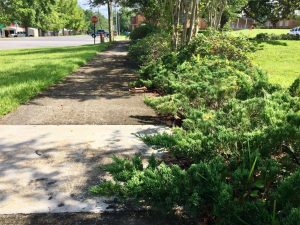
Consider removing spreading junipers growing over sidewalk with too much shade. Credit: Larry Williams
There are plants that are best removed from the landscape. They may become overgrown or become less than aesthetically pleasing. That’s a nice way to say they are ugly. The area may look better after removing old, declining, overgrown plants. Consider removing plants that require too much maintenance or that are pest prone.
Late summer through fall is a good time to do a walk-through of your landscape. Make notes if necessary as you visually inspect the plants. You get to see the plants that did great, the plants that didn’t do so great. You can make decisions on which plants to do away with, which to keep and which plants were more trouble than they were worth from a maintenance standpoint.
As you inspect your landscape, ask yourself questions. You can easily identify problem areas in the lawn. As you identify problem areas in the lawn, attempt to determine why those areas aren’t doing so well. Begin formulating plans for correcting those areas. Decide if renovating and replanting with grass is your best option. Or something other than grass may be the best option, particularly if there is a history of problems with grass in a specific location.
As a rule, when there is less than sixty percent coverage of the desirable lawn grass left, reestablishment should be considered. With time, the original lawn grass simply may have died out, leaving a mix of weeds, some of the original lawn grass, a volunteer grass in the mix and some bare ground. In the process of starting over, decide where lawn grass is needed or where it serves a purpose and consider other options in areas where grass may not be needed or where grass does not historically grow well.
It may be time to replace an older, declining plant with something new. There may be a plant that hasn’t performed up to par but that would do better if moved to a more appropriate location. Fall through early winter is a good time to relocate plants. Now is a good time to take a soil sample and possibly take the guesswork out of liming or fertilizing. The UF/IFAS Extension Office in your County can provide information on how to collect and submit a soil sample.

by Lauren Goldsby | Oct 23, 2025
One of my favorite ways to spend the morning lately is in the garden drinking my coffee. There’s no intended purpose, other than to look and see what I can find. I always end up finding something interesting! Scouting your garden does not have to be a formal process, but it is more effective when done regularly. This can help to avoid the “it happened overnight!” phenomenon that we hear frequently. Pests and diseases do not typically cause damage that quickly. Regular scouting helps you notice small symptoms before they become big problems. Training your brain to notice these small changes happens over time with your scouting, but just like any new skill, you need to practice! Give it a chance and watch the tiny world open up around you. Come scout the garden and see what we find.
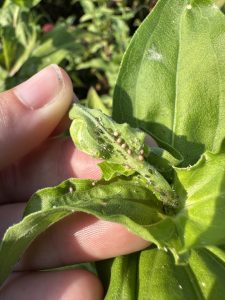
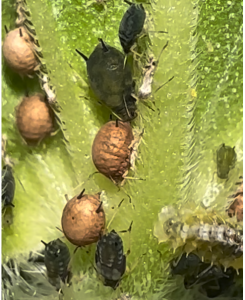
In this photo you can see a close up of the mummified vs. regular aphids. For more information on parasitic wasps and other natural enemies see: https://edis.ifas.ufl.edu/publication/IN120
I noticed some wrinkled leaves on the new growth of a zinnia. Wrinkled new growth can be a sign that a piercing-sucking insect is causing damage. Turning over the leaves revealed aphids, a common culprit on zinnia. In this photo we can see aphids in a few different life stages. Importantly, we also see that some of the aphids are serving as food for beneficial insects. These mummified aphids are the ones you see with tan, golden bodies that are larger and more round. A small, parasitic wasp larvae, is living inside the aphids body– using it for protection and food until it is ready to emerge. These are good signs of a healthy working ecosystem and they can help keep aphid populations in control. This helps me to know that there are aphids in my zinnias, but that I don’t need to do anything about them right now. Natural predators are at work and can be more effective than chemical applications at this time. If you need help identifying insects in your garden, reach out to your local extension office. Not all insects on our plants are causing harm; and some are actually helping decrease pests.
I don’t always find pests in the garden. Sometimes I realize the irrigation timer was turned off or I take a really pretty picture for my instagram story (see below). These are still wins in my book! Remember that your landscape is an entire ecosystem and you are a part of it. It’s a great practice to walk around and take an intentional look at your plants when you get the chance, you may see something cool!
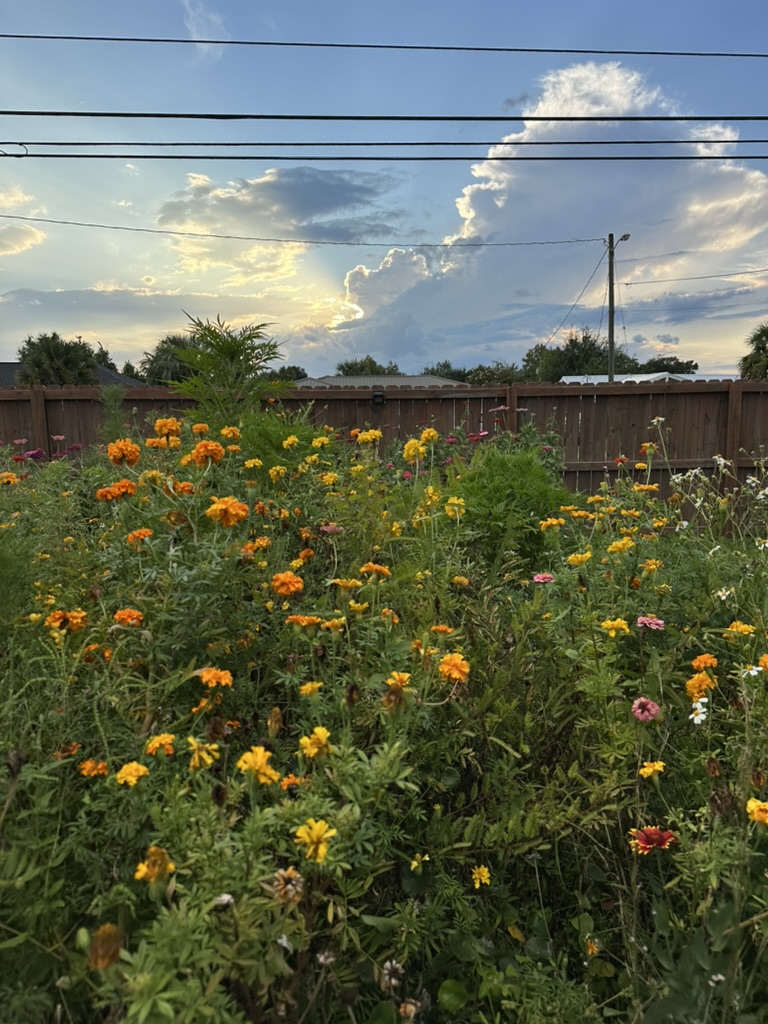

by Beth Bolles | Oct 23, 2025
One of our well known spiders found in landscapes is the Yellow and black garden spider, Argiope aurantia. Most people will recognize this beautiful spider that rests in a large web with a zigzag web pattern in the middle called a stablementum. A wide variety of insects will be caught in the web throughout the summer, with many prey larger than the spider itself. The Yellow and black orb weaver is just one of our beneficial spiders in landscapes.
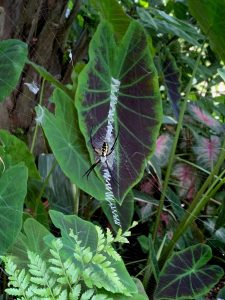
Garden spider waiting for a meal. Photo by Beth Bolles, UF IFAS Extension Escambia County.
As fall approaches each female garden spider leaves us a wonderful gift in the garden. She will create a very distintive egg sac that can be hidden in plants or hang in the corner of a porch. The sac is brown and pear shaped, supported by strands of web attached to branches or structures. Hundreds of eggs are inside and although they hatch in late fall, the spiderlings will stay in the sac until the spring. A large number of spiderlings will not survive due to predation and other factors, but a few will continue development to adorn your garden in the following season.
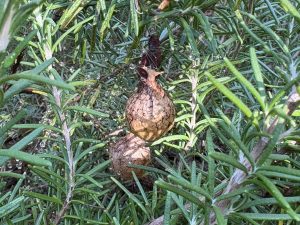
Egg sacs of the Yellow and black garden spider in a rosemary. Photo by Beth Bolles, UF IFAS Extension Escambia County.
If you did have a garden spider in your landscape this summer, just be a little more careful when maintaining plants. You don’t want to accidently remove the overwintering egg sac. Although this large spider can be startling for many people, they are not aggressive and are considered beneficial in the garden.
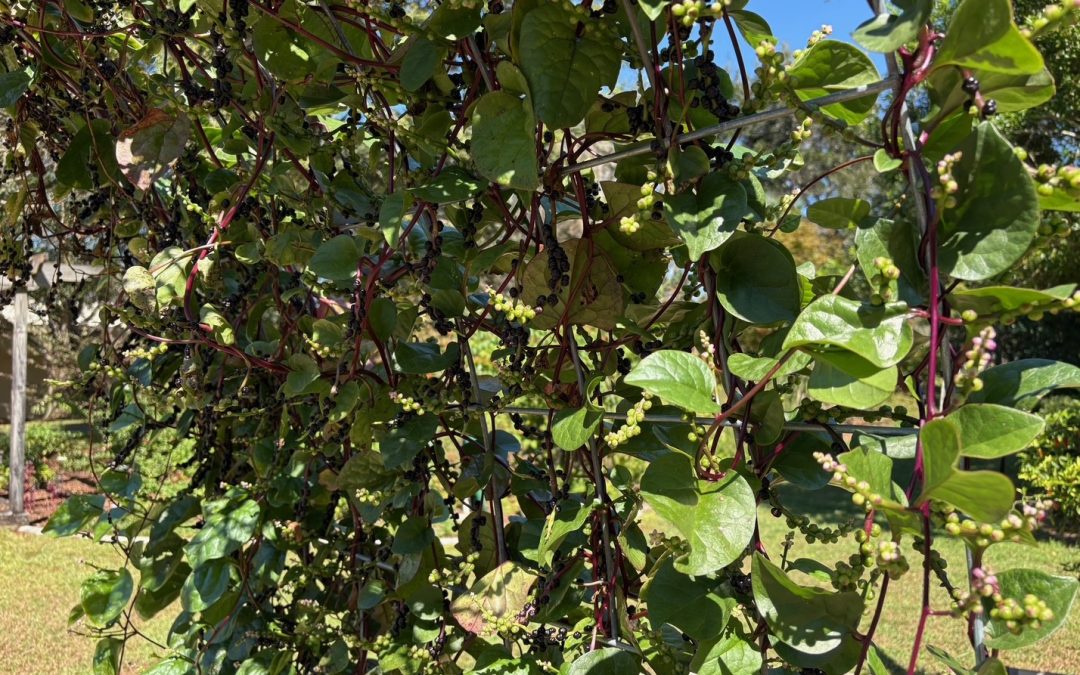
by Beth Bolles | Oct 17, 2025
Saving seeds is a wonderful garden activity that gives us both a sense of pride in our gardening skills and helps us save a few dollars on new seeds.
Malabar spinach is one of our heat loving vines that grows well until frost and produces abundant seed. If you are looking for a leafy green spinach substitute, Malabar spinach does very well in the summer garden. We had a late start on planting our Malabar spinach in the Escambia Extension garden so the seeds are now ripening. This is the perfect plant for saving seeds.
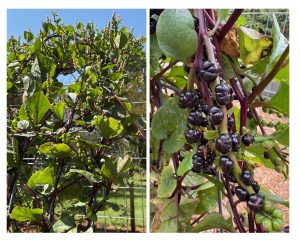
Vines growing along with mature fruit. Photos by Beth Bolles UF IFAS Extension Escambia County.
Malabar spinach has plenty of fruit for you to save seeds for yourself and friends. When mature, fruit will be dark purple and you may easily pull the fruit off stems into a small container. This is definitely a practice that requires gloves unless you want to have your hands stained purple for a while.
Your next step is to lightly press on the fruit while running them under water. Have a strainer underneath to catch the fruit. You are just trying to loosen some of the pulp, not remove every bit. Fill a small jar 3/4ths with water and then add your fruit. Let this sit on a counter for a few days. You may change out the water as needed. This is the step that loosens the remaining pulp from around the seeds.
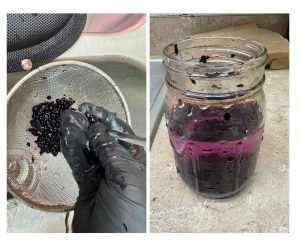
Loosening pulp from seeds and then soaking in water. Photos by Beth Bolles, UF IFAS Extension Escambia County.
After several days in the jar, pour the jar liquid through a strainer and wash over it with clean water. This removes the final bits of pulp. Place a paper towel or cloth on the counter and lay out your cleaned seeds. They will need to air dry for a couple of days. Keep seeds away from a heat source and out of the sun.
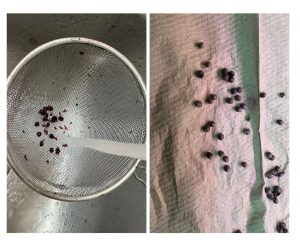
Final rinse of seeds and drying on towel. Photos by Beth Bolles, UF IFAS Extension Escambia County.
Once dry, you are ready to package your seeds for next season’s planting or gifts for friends. You may use a paper envelope or small plastic bag. You may also add seeds to a jar, close it tightly, and put in the refrigerator. Label your package with the plant and date because you will not remember those details later.
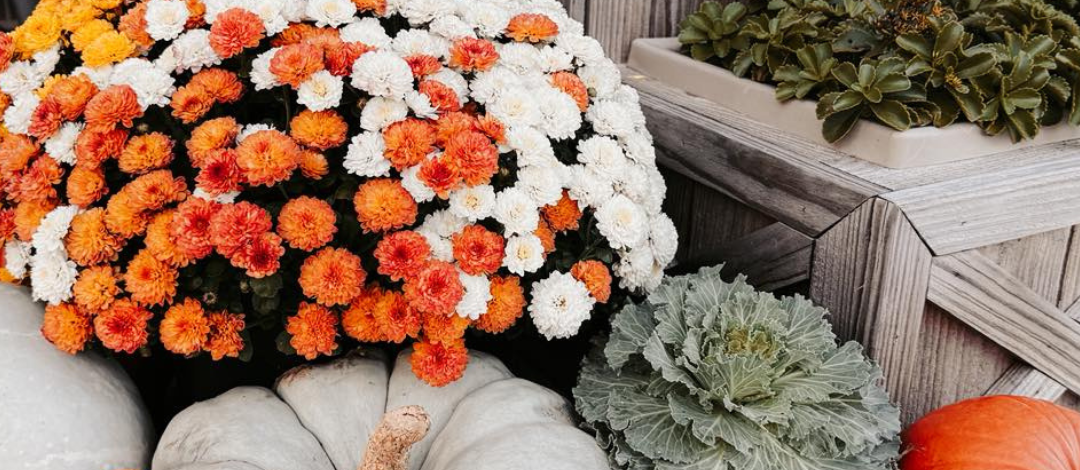
by Abbey Smith | Oct 17, 2025
If you have walked through any retail garden centers lately, you probably have seen some bright colored fall flowers. These pretty plants are what we call mums, or chrysanthemums. Mum flowers are a fall staple in the south to see on a front porch or any fall decorated scape. They pair great with an heirloom pumpkin or some ornamental kale. Growing up in Kentucky, mums are everywhere you turn this time of year. But how can you make the most of your mums this fall? Follow along for great tips to keep your mums fresh for the next several weeks.
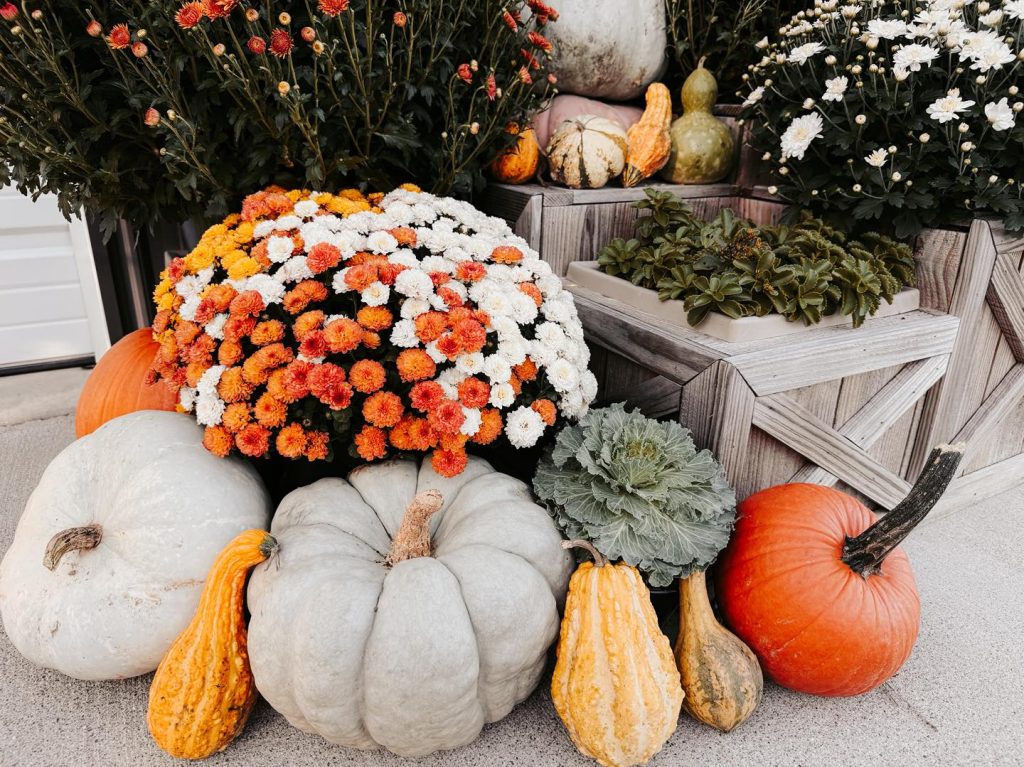
Mum Fall Design. Photo Credit: Danielle Allen, Glory Goods- Irvington, KY
When shopping for the perfect mum for your porch, it is best to try and select a pot that has not fully bloomed yet. Chrysanthemums come in a variety of colors and some varieties even bloom more than one color (I love Candy Corn Mums!), but it is crucial to choose a plant that is not showing any color at all yet. The more blooms, the less life span you will get. Many wholesale mum growers will “de-head” the blooms or remove the buds appearing closest to opening when they are closer to market time to keep the inventory prettier for the consumer. It’s also important to select plants that look healthier. Mums bloom in a mounding fashion, so having uneven bloom patterns or discoloration is not a good sign. It’s also good practice to remove blooms as they begin to die off to make room for new ones.
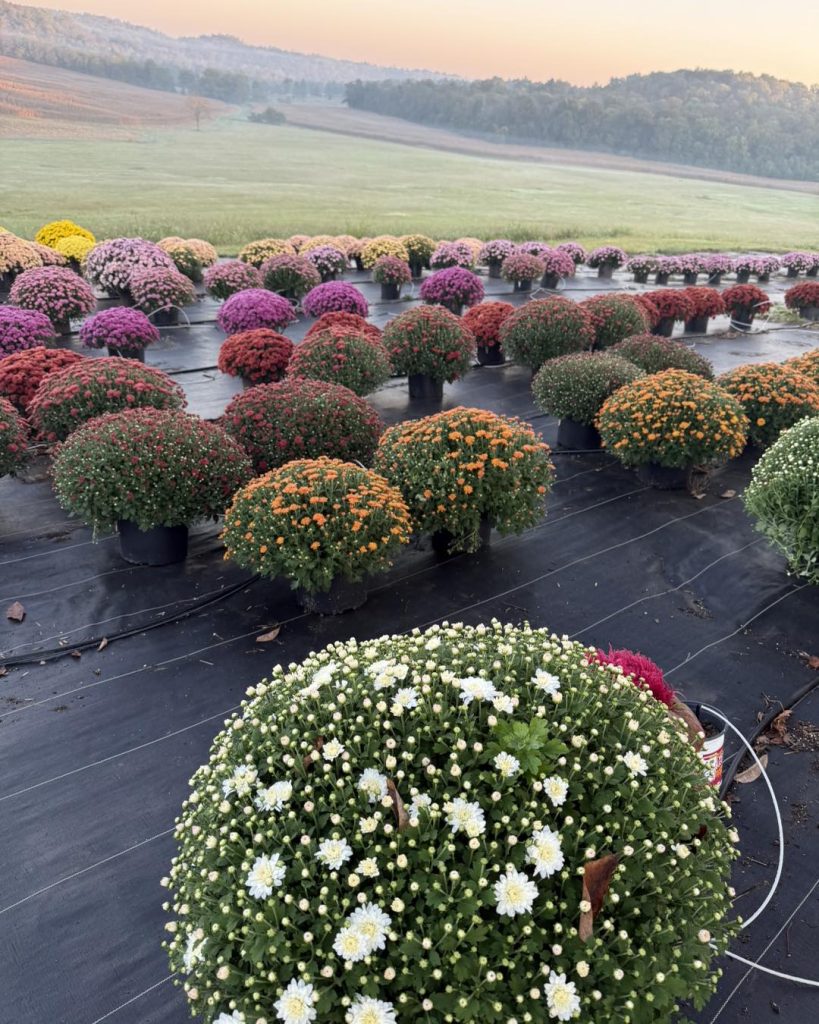
Glory Goods Mum Wholesale Growing Pad. Photo Credit: Danielle Allen, Glory Goods- Irvington, KY
In the last several weeks in Jackson County there has been little to no rain fall. It’s important during dry spells like these to keep your mums saturated but not sopping wet. Mum flowers love to be watered from the bottom. To do this, set the pot in a bucket of water no longer than 15 minutes at a time to allow the soil to hydrate thoroughly. Watering your mum from the top can increase chances of bacteria and fungus growing on your blooms and can cause uneven blooming patterns. Mums need full sun to grow, so monitoring their dryness is important so your plants don’t dry out completely.
Okay, so Halloween is over, you hear the turkey gobbling, and Santa’s sleigh is on the horizon; this doesn’t mean throw out your mums! You can easily keep your mums in containers until December, but there is a risk of frost. When the temps drop below 40 degrees Fahrenheit at night, covering mums with old towels or sheets and removing them in the morning is best practice to keep your blooms frost-safe. You can also plant your mums in the ground. If you chose to do this, it is best to amend with compost as most mums are not acclimated to sandy soil.
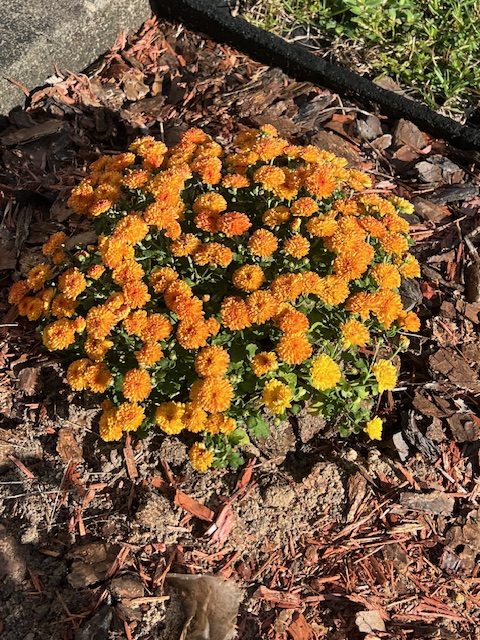
Mum in the Ground. Photo Credit: Abbey Smith, UF/IFAS Extension
For more information, please visit:
https://gardeningsolutions.ifas.ufl.edu/plants/ornamentals/chrysanthemums/
https://nwdistrict.ifas.ufl.edu/hort/2024/10/17/mums-the-word-on-fall-color/

















